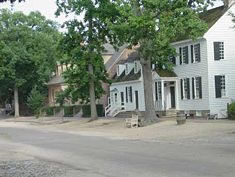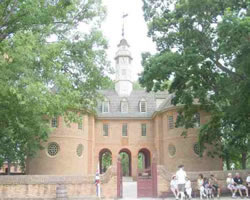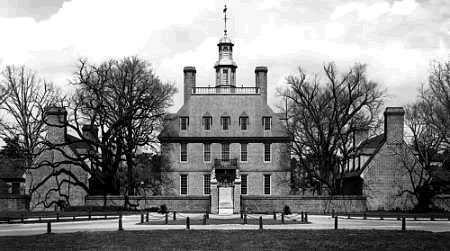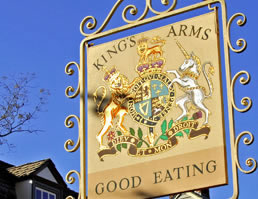Williamsburg
was first settled in 1632. It was originally
called Middle Plantation. In 1693, the
College of William and Mary, named after
the King and Queen of England, was established
in Middle Plantation. Thomas Jefferson
and George Washington were among those
who attended the college.
In
1699, a year after the statehouse burned
for a second time in Jamestown, the capital
of the Virginia colony was moved to Middle
Plantation. Middle Plantation was built
on higher ground than Jamestown, had an
adequate supply of fresh water, was not
infested with mosquitoes, and featured
the facilities of the new college. Later
that year, the town was renamed Williamsburg
after the King.
In
1705, America's first state capitol building
was built on Duke of Gloucester Street
in Williamsburg. Williamsburg would soon
become the social, political, and economic
center of Virginia. It was the site of
America's first theater and Virginia's
first successful newspaper, The Virginia
Gazette. In 1722, it was granted a royal
charter as a city.
Williamsburg
remained capital of Virginia until 1779.
During the Revolutionary War, Governor
Thomas Jefferson permanently moved the
capital to Richmond because he thought
Williamsburg was vulnerable to a British
attack.
|
Duke
of Gloucester Street
|

Duke of Gloucester Street
is the principal street running through Colonial
Williamsburg. The Virginia General Assembly
named it after his Highness the Duke of Gloucester
in 1699. Originally a narrow Indian path
called a "trace," the
street originally ran through various swamps
and was blocked by a series of houses that
were demolished in 1704. The street's current
path was designed over 300 years ago and
was constructed to be 99 feet wide and run
for one mile from the College of William
and Mary to the Capitol building. In its
early history, the street was full of potholes
and irregularities. It was said that horse-drawn
carriages, wagons, or oxcarts traveling
down the street would kick up clouds of choking
dust. After periods of rain, the street would
turn into a giant puddle of mud and water.
After the capitol was moved from Williamsburg
to Richmond, the street, and much of Williamsburg
were neglected. By the early 1900's, however,
interest in Williamsburg returned and a vision
for a "living, outdoor
history museum" was born. Major restorations
projects were completed in the 1930's and by
1969, the street was closed to all automobile
traffic.
Today, Duke of Gloucester Street has been
totally restored and is the center of action
in Williamsburg. Millions walk along the
street to visit the inns, taverns, and colonial
exhibitions every year. President Franklin
D. Roosevelt called it "the most historic
street in America. |
|

The Virginia House of
Burgesses decided to move the capitol from
Jamestown to Middle Plantation in 1698, after
a fire destroyed the state house building
built in Jamestown. In 1699, Henry Cary was
contracted to build America's first capitol
building. Cary's building was massive; it
was actually two buildings connected by an
arcade that featured three archways. The
first floor on the west side of the building
was designed for use as a General Court while
the east side was used as a meeting place
for the House of Burgesses. The second floor
housed the Council Chamber, the Council Clerk's
office, and a lobby, and was highlighted
by a beautiful six-sided cupola on the ridge
of the roof. In 1705, the building was completed.
The building was constructed without fireplaces
to prevent a catastrophic fire. In 1723,
chimneys were added for fireplaces in an
attempt to keep the building dry. In 1747,
however, the building burned to the ground,
and only a few walls were left standing.
In 1748, the Virginia Legislature voted to
rebuild the building, a measure that was
only approved by two votes.
In 1753, the Capitol building was rebuilt.
Famous Virginians such as Patrick Henry,
George Washington, and Thomas Jefferson voiced
their opinions concerning British taxes that
led to the American Revolution from within
the walls of the Williamsburg Capitol. After
the capitol city was moved to Richmond, the
Williamsburg capitol building was used for
a variety of functions, but parts of it were
demolished to make use of its bricks, and
other parts were burned by a fire. By 1881,
it was completely gone.
In 1928, the property was sold to Colonial Williamsburg and the capitol building
was rebuilt. Today, Virginia legislators use it as a ceremonial meeting ground
for one day every other year. It is one of the most popular attractions for tourists
visiting Colonial Williamsburg. |
|

Construction of the
Williamsburg Governor's Palace was authorized
in 1705. Henry Cary, the contractor who built
the Capitol building, got the job. The palace
was to be built on 63 acres and was to include
sash windows, a kitchen, cellar, vault, and
stables. Building continued on and off until
1710, when Cary was replaced by John Tyler.
When Alexander Spotswood became governor
after the death of Governor Nott, he requested
additional funds to be spent on building
outbuildings, furniture, ornaments and gardens.
In 1718, the building was finally completed
and Spotswood took up residence, despite
grumbles from the House of Burgesses that
the palace was too expensive.
When completed, the magnificent palace featured
three floors, each nearly 3,400 square feet.
Its cellar was large enough for eleven wine
bins and the second floor featured an iron
balcony. Inside the gates to the palace were
two large one and a half story brick advance
buildings. There was also a stable, carriage
house, kitchen, scullery, laundry, and an
octagonal bathhouse, arranged near the advance
buildings. In 1751, Governor Dinwiddie ordered
the building of a ballroom, additional rooms,
and public houses to showcase the palace
as a gathering place for social activities
and entertainment. Despite its grandeur,
it was considered much inferior to similar
buildings in Europe. The property was generally
attended by 25 slaves and servants, who lived
in the outbuildings. Butlers greeted guests
and sorted out which visitors were authorized
to see the governor. Elegant balls and ceremonies
were hosted at the palace to celebrate the
birthdays of the governor and his family
members, or, to mark the arrival of dignitaries
or celebrate holidays. Governors Patrick
Henry and Thomas Jefferson were among those
who called the palace home before Williamsburg
was abandoned as Virginia's capitol. In 1781,
it served as a hospital for those wounded
in the Battle of Yorktown. 156 casualties
of the battle were buried on the palace grounds.
That same year, the building was destroyed
by a fire and its usable bricks were sold.
Like many of the buildings and monuments
in Williamsburg, the Governor's palace was
rebuilt in the 1930's. Its restoration was
carefully performed throughout the remainder
of the 20th century with attention paid to
its original blueprints, architecture, and
decor. It remains one of the most popular
attractions in Colonial Williamsburg. |
|
| The magnificent palace
green was built with a purpose. It was originally
built to draw the viewer's eyes to the city's
most impressive building and source of power
- the Governor's Palace. In the 18th Century
however, luxurious homes were built on the
palace green, including the home of George
Wythe. |
| |
College of William and
Mary
|

The College of William
and Mary, the nation's second oldest college,
was chartered by King William III and Queen
Mary II in 1693. The royal charter required
the new college to be organized into a divinity
school, a grammar school, and a philosophy
school. The college opened in 1694 and students
attended classes in temporary buildings.
By 1695, the school's first building, the
Wren Building, was completed at the west
end of Duke of Gloucester Street. The college
quickly became the intellectual and cultural
center of the new capital city. George Washington,
Thomas Jefferson, John Marshall and James
Monroe were among its many famous graduates.
In all, 16 signers of the Declaration of
Independence were educated at W &M. It
even issued George Washington his surveyor's
certificate. In 1776, the honor society Phi
Beta Kappa was founded at the university
and in 1779, it became the first college
to become a university when it established
faculties of law and medicine.
Today, the College of William and Mary remains one of America's most prestigious
public universities, and has produced five Rhodes Scholars since 1988. |
|
| The Williamsburg Public
Gaol was authorized in 1701, shortly after
it became capitol of the Virginia Colony. It
was used primarily to jail debtors, slaves,
and mentally ill people. It was also used for
those awaiting trial or punishment such as
whipping, branding, or hanging. The gaol was
a miserable place and many of the cells were
only ten feet by ten feet and held five or
six prisoners. Many prisoners developed what
was known as Gaol Fever (likely Typhus). In
total, the gaol held eight cells, quarters
for the gaol keeper, and a courtyard. The last
keeper of the gaol, Peter Pelham, had at least
five children who grew up in the gaol. |
|
The Raleigh Tavern was
originally built in 1717 and was named for
Sir Walter Raleigh. It was a popular meeting
location for influential Virginians before
the American Revolution and often hosted
balls, lavish parties, and festivals. In
1769, however, the Virginia House of Burgesses
was dissolved by the British Crown because
of their vocal opposition to the Townshend
Acts. The Raleigh Tavern would soon be transformed
into a meeting place for Virginia's revolutionaries.
In retaliation, the former burgesses, who
included Thomas Jefferson, Patrick Henry,
George Mason, "Lighthorse" Harry
Lee and others met at the tavern's Apollo
Room to develop plans of action against the
British, which included the formation of
the intercolonial Committee of Correspondence
enabling the colonies to communicate with
each other.
In 1776, a group of students from the College of William and Mary met at Raleigh
Tavern and formed Phi Beta Kappa. It was also the site of a grand celebration
of the 50th anniversary of the Treaty of Paris in 1824. Here, the French General
Marquis de Lafayette was honored and John Marshall and John C. Calhoun attended.
In 1859, the Raleigh Tavern burned to the ground and was not rebuilt until 1932. |
|

The King's Arms Tavern
was a popular dining option for Williamsburg's
elite, where they could talk about business,
politics, and eventually independence. Established
in 1772, the original tavern included stables
and a smokehouse. During the Revolution, it
would become known as Vobe's Tavern and then
Eagle Tavern. The owner of the tavern, Mrs.
Jane Vobe, was well-known for her fine cooking.
George Washington and Baron Von Steuben were
among those who frequented the establishment.
This tavern was unique because Mrs. Vobe sold
tickets for the theatre, had artists display
their work and posted rewards for the return
of lost articles within the business. In addition,
one of Vobe's slaves who worked at the tavern,
Gowan Pamphlet, would become the pastor and
founder of the only Baptist church in Williamsburg,
as well as a free man and landowner in both
Williamsburg and James City.
Williamsburg Articles and Activities
13 Colonies Navigation
Other 13 Colonies Articles
|
|